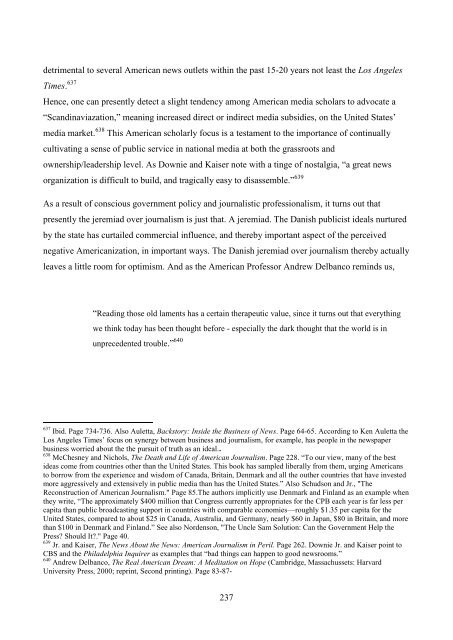The Jeremiad Over Journalism
The Jeremiad Over Journalism
The Jeremiad Over Journalism
You also want an ePaper? Increase the reach of your titles
YUMPU automatically turns print PDFs into web optimized ePapers that Google loves.
detrimental to several American news outlets within the past 15-20 years not least the Los Angeles<br />
Times. 637<br />
Hence, one can presently detect a slight tendency among American media scholars to advocate a<br />
―Scandinaviazation,‖ meaning increased direct or indirect media subsidies, on the United States‘<br />
media market. 638 This American scholarly focus is a testament to the importance of continually<br />
cultivating a sense of public service in national media at both the grassroots and<br />
ownership/leadership level. As Downie and Kaiser note with a tinge of nostalgia, ―a great news<br />
organization is difficult to build, and tragically easy to disassemble.‖ 639<br />
As a result of conscious government policy and journalistic professionalism, it turns out that<br />
presently the jeremiad over journalism is just that. A jeremiad. <strong>The</strong> Danish publicist ideals nurtured<br />
by the state has curtailed commercial influence, and thereby important aspect of the perceived<br />
negative Americanization, in important ways. <strong>The</strong> Danish jeremiad over journalism thereby actually<br />
leaves a little room for optimism. And as the American Professor Andrew Delbanco reminds us,<br />
―Reading those old laments has a certain therapeutic value, since it turns out that everything<br />
we think today has been thought before - especially the dark thought that the world is in<br />
unprecedented trouble.‖ 640<br />
637 Ibid. Page 734-736. Also Auletta, Backstory: Inside the Business of News. Page 64-65. According to Ken Auletta the<br />
Los Angeles Times‘ focus on synergy between business and journalism, for example, has people in the newspaper<br />
business worried about the the pursuit of truth as an ideal..<br />
638 McChesney and Nichols, <strong>The</strong> Death and Life of American <strong>Journalism</strong>. Page 228. ―To our view, many of the best<br />
ideas come from countries other than the United States. This book has sampled liberally from them, urging Americans<br />
to borrow from the experience and wisdom of Canada, Britain, Denmark and all the outher countries that have invested<br />
more aggressively and extensively in public media than has the United States.‖ Also Schudson and Jr., "<strong>The</strong><br />
Reconstruction of American <strong>Journalism</strong>." Page 85.<strong>The</strong> authors implicitly use Denmark and Finland as an example when<br />
they write, ―<strong>The</strong> approximately $400 million that Congress currently appropriates for the CPB each year is far less per<br />
capita than public broadcasting support in countries with comparable economies—roughly $1.35 per capita for the<br />
United States, compared to about $25 in Canada, Australia, and Germany, nearly $60 in Japan, $80 in Britain, and more<br />
than $100 in Denmark and Finland.‖ See also Nordenson, "<strong>The</strong> Uncle Sam Solution: Can the Government Help the<br />
Press? Should It?." Page 40.<br />
639 Jr. and Kaiser, <strong>The</strong> News About the News: American <strong>Journalism</strong> in Peril. Page 262. Downie Jr. and Kaiser point to<br />
CBS and the Philadelphia Inquirer as examples that ―bad things can happen to good newsrooms.‖<br />
640 Andrew Delbanco, <strong>The</strong> Real American Dream: A Meditation on Hope (Cambridge, Massachussets: Harvard<br />
University Press, 2000; reprint, Second printing). Page 83-87-<br />
237
















